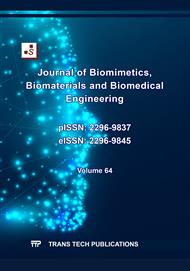[1]
J.Y. Han, Y.H. Wang, D.Q. Wan, Research progress and development trend of lower limb exoskeleton rehabilitation robot, Journal of Shanghai Jiao Tong University (Medical Edition), 42(2022)241-246.
Google Scholar
[2]
C.J. Song, Research on intention recognition and gait planning of exoskeleton robot based on myoelectric signals, Harbin: Harbin Institute of Technology (2018).
Google Scholar
[3]
X.L. Gu, T.C. Song, W.T. Chen, et al, Identification of six upper limb action EMG signals based on MATLAB, Mechanical Engineer, 5(2022) 17-19.
Google Scholar
[4]
T. Kang, Human motion intention recognition based on surface electromyography, Chengdu: University of Electronic Science and Technology of China (2021).
Google Scholar
[5]
Q.S. Ai, Y.N. Zhang, W.L. Qi, et al, Research on Lower Limb Motion Recognition Based on Fusion of sEMG and Accelerometer Signals, Symmetry, 9(2017)147.
DOI: 10.3390/sym9080147
Google Scholar
[6]
X.G. Xi, M.Y. Tang, S.M. Miran, et al, Evaluation of Feature Extraction and Recognition for Activity Monitoring and Fall Detection Based on Wearable sEMG Sensors, Sensors, 17(2017) 1229.
DOI: 10.3390/s17061229
Google Scholar
[7]
P. Huang, Y.P. Li, X.Y. Lv, et al, Recognition of Common Non-Normal Walking Actions Based on Relief-F Feature Selection and Relief-Bagging-SVM, Sensors, 25(2020)1447.
DOI: 10.3390/s20051447
Google Scholar
[8]
G.W. Favieiro, A. Balbinot, Paraconsistent Random Forest: An Alternative Approach for Dealing with Uncertain Data, IEEE Access, 7(2019)1479.
DOI: 10.1109/access.2019.2946256
Google Scholar
[9]
P. Gopal, A. Gesta, A. Mohebbi, A Systematic Study on Electromyography-Based Hand Gesture Recognition for Assistive Robots Using Deep Learning and Machine Learning Models, Sensors, 22(2022)3650.
DOI: 10.3390/s22103650
Google Scholar
[10]
N. Jose, R. Raj, P.K. Adithya, et al, Classification of Forearm Movements from sEMG Time Domain Features Using Machine Learning Algorithms, 2017 IEEE Region 10 Conference (TENCON), Penang, MALAYSIA: IEEE (2017)1624-1628.
DOI: 10.1109/tencon.2017.8228118
Google Scholar
[11]
G. Song, Y.C. Wang, M.M. Wang, et al, Lower Limb Movement Intent Recognition Based on Grid Search Random Forest Algorithm, 3rd International Conference on Robotics, Control and Automation (ICRCA '18), New York, NY, USA: Association for Computing Machinery (2018)225-229.
DOI: 10.1145/3265639.3265644
Google Scholar
[12]
Z. Li, X.R. Guan, K.F. Zou, et al, Estimation of Knee Movement from Surface EMG Using Random Forest with Principal Component Analysis, Electronics, 9(2020)43.
DOI: 10.3390/electronics9010043
Google Scholar
[13]
P. Zhang, J.X. Zhang, R.H. Liu, et al, Research on lower limb action recognition based on GA-RBF neural network and sEMG, Chinese Journal of Biomedical Engineering, 41(2022)41-47.
Google Scholar
[14]
H. Kumar, N. Ganapathy, S.D. Puthankattil, et al, Classification of Emotional States Using EEG Signals and Wavelet Packet Transform Features, Studies in health technology and informatics, 294(2022)943-944.
DOI: 10.3233/shti220632
Google Scholar
[15]
P.A. Karjalainen, F.R. Gao, T.X. Tian, et al, Human Gait Recognition Based on Multiple Feature Combination and Parameter Optimization Algorithms, Computational Intelligence and Neuroscience (2021)1-14.
DOI: 10.1155/2021/6693206
Google Scholar
[16]
Y. Lu, H. Wang, F. Hu, et al, Effective recognition of human lower limb jump locomotion phases based on multi-sensor information fusion and machine learning, Medical & Biological Engineering & Computing, 59(2021)883–899.
DOI: 10.1007/s11517-021-02335-9
Google Scholar
[17]
W.T. Chen, J. Zhuang, W.X. Yu, et al, Measuring complexity using FuzzyEn, ApEn, and SampEn, Medical Engineering & Physics, 31(2009)61-68.
DOI: 10.1016/j.medengphy.2008.04.005
Google Scholar
[18]
Z. Farhadi, H. Bevrani, M.R. Feizi-Derakhshi, et al, An Ensemble Framework to Improve the Accuracy of Prediction Using Clustered Random-Forest and Shrinkage Method, Applied Sciences, 12(2022)10608.
DOI: 10.3390/app122010608
Google Scholar
[19]
T.T. Joy, S. Rana, S. Gupta, et al, Hyperparameter Tuning for Big Data using Bayesian Optimization. 2016 23rd International Conference on Pattern Recognition (ICPR), Cancun, MEXICO: Mexican Assoc Comp Vis Robot & Neural Comp (2016)2574-2579.
DOI: 10.1109/icpr.2016.7900023
Google Scholar
[20]
S.L. Bai, D.J. Ying, Systematic Anatomy, eight ed., People's Health Publishing House, Beijing, 2013.
Google Scholar
[21]
P. Jacqueline, M.B. Judith, S.Y. Jiang, Gait analysis: normal and pathological functions, first ed, Shanghai Science and Technology Press, Shanghai, 2017.
Google Scholar
[22]
P. Huang, J. Qi, L.F. Deng, et al, Surface electromyographic analysis of lower limb muscles in normal young adults with natural gait, Chinese Organization Engineering Research, 16(2012)3680-3684.
Google Scholar
[23]
G. Tang, Biomechanical simulation analysis of typical human sports, Shanghai: Shanghai Jiao Tong University (2011).
Google Scholar
[24]
C.C. Hang, Research on lower limb motion intention recognition based on sEMG signal, Wuhan: Wuhan University of Technology (2019).
Google Scholar
[25]
H.Y. Zhao, Z.B. Qiu, D.Y., Peng et al, Prediction of Joint Angles Based on Human Lower Limb Surface Electromyography, Sensors, 23(2023)5404.
DOI: 10.3390/s23125404
Google Scholar
[26]
S. Issa, A.R. Khaled, Lower Limb Movement Recognition Using EMG Signals, Intelligent Systems Design and Applications, 418(2022)336–345.
DOI: 10.1007/978-3-030-96308-8_31
Google Scholar
[27]
P.J. Qin, X. Shi, Evaluation of Feature Extraction and Classification for Lower Limb Motion Based on sEMG Signal, Entropy, 22(2020)852.
DOI: 10.3390/e22080852
Google Scholar
[28]
Z.M. Guo, C. Wang, C.N. Song, A real-time stable-control gait switching strategy for lower-limb rehabilitation exoskeleton, PLoS ONE, 15(2020) e0238247.
DOI: 10.1371/journal.pone.0238247
Google Scholar
[29]
P.N. Wei, J.H. Zhang, F.F. Tian, et al, A comparison of neural networks algorithms for EEG and sEMG features based gait phases recognition, Biomedical Signal Processing and Control, 68(2021)102587.
DOI: 10.1016/j.bspc.2021.102587
Google Scholar


